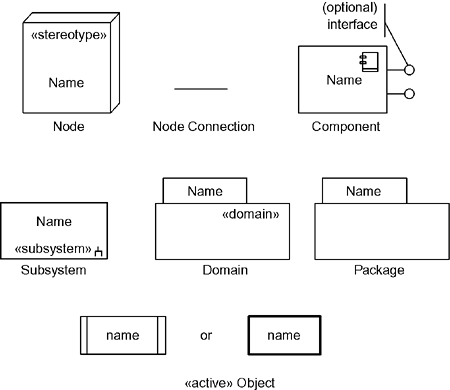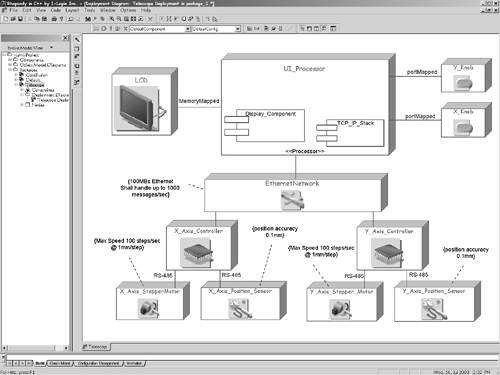8.3 Software Meets Hardware: Deployment Architecture in UML
| The UML represents hardware/software mapping with deployment diagrams. There are a number of important diagrammatic elements, as shown in Figure 8-17. The icon of primary importance on deployment diagrams is the node. Nodes represent processors, sensors, actuators, routers, displays, input devices, memory, custom PLAs, or any physical object of importance to the software. Typically, nodes are stereotyped to indicate the type of node. Interconnects represent physical interconnections among nodes. They are most commonly electronic, but can as easily be optical or telemetric. Figure 8-17. Deployment Diagram Notation
Classes are part of the logical architecture of the system. That it, the represent the logical concepts of the system and low they are inherently linked together. Subsystems, components, tasks, and objects are part of the physical architecture. A component is an artifact of development that exists at runtime. Typical components are executables, libraries, files, configuration tables, and so on. Such software artifacts end up deployed on hardware this is represented by the node and may communicate across physical linkages. See Figure 8-17. Nodes are often divided into two fundamental kinds those that run software that we produce (processors) and those that do not (devices). These are often stereotyped into more specific kinds of hardware, such as DC motors, stepper motors, laser ranger finders, displays, buttons, keyboards, pressure sensors, and the like. You don't have to stereotype the nodes, but many people do and like to use special icons to represent the various hardware devices. There are always many ways that a logical architecture can be mapped to a physical architecture. In fact, the same logical architectural elements may end up instantiated in multiple components. For example, many components may have to communicate with each other across a bus. They may all contain classes to assist the marshalling and unmarshalling of resources for bus transfer. Processor nodes are occasionally shown containing classes or objects, but usually processor nodes contain components that may be broken down into subcomponents and tasks (represented as «active» objects). To show tasks, include the «active» objects in the component on the diagram. Of course, these components are the realization of objects and classes, but classes and objects usually only appear on class and object, not deployment, diagrams. Figure 8-18 shows a simple deployment diagram for a telescope position control system. The user interface consists of an LCD display and two rotary encoder knobs, which are tied to the same processor. The positioning subsystem consists of two independent subsystems, each containing a stepper motor and an independent sensor. The processors are linked across an Ethernet network, and both use Ethernet controller boards to access the network. Figure 8-18. Telescope Position Controller Deployment Diagram
This figure shows two methods for specifying the software running on the processors. The first is shown in the UI Processor node. This node contains software components; in this case, a Display component and a TCP/IP protocol stack. The stereotype «processor» is shown textually. The other two notation processors, controllers for the x and y axes, use the iconic form to show their stereotype. The devices are also shown using iconic stereotype forms. |
EAN: 2147483647
Pages: 127

